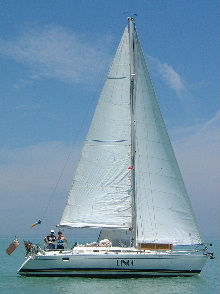
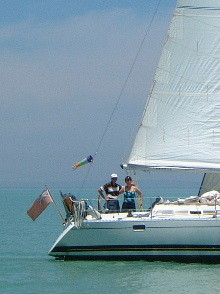
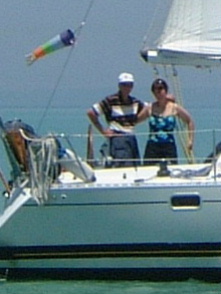
A record of the Altwasser family's sailing experiences in their yacht Bingo
Posted
by Richard at 6:38 PM
Santa Ponsa to Sicily via Sardinia and Tunis 652 miles.
May 11th to June 14th 2004. 
Perhaps George Orwell would turn in his grave in Sutton Courtenay churchyard to learn that although internet cafes try to allow egalitarian access to cyberspace, some are more equal than others. The common inability to support file transfer protocol, needed to update this website, is my excuse for a six week gap. However, six weeks’ travel news, more than 50 pictures and pages of ramblings may be just what you need for a light break from Wimbledon, Henley and the European qualifying matches.
May 11th to Thursday May 13th 2004. Santa Ponsa to Colonia de Sant Jordi, Mallorca. 35 miles.
Dave and Pauline offer motor yacht tours of Mallorca in their Targa 33 based at Santa Ponsa yacht harbour. We learnt they wished to exchange their large, heavy inflatable dinghy for a smaller, lighter one, more suitable for multiple launches during a day’s tour. We wished to increase our dinghy size to give more comfort at anchor so we swapped our new 2 meter dinghy and 2.5hp outboard for their older 2.6 metre dinghy and 4 hp outboard. As summer marina prices rise and the weather becomes settled, we now intended to spend time at anchor, for which a larger dinghy would make life easier.
During our first two nights at anchor in Santa Ponsa bay and nearby Cala Fornells, we recorded 35 knot winds, but were able to dinghy ashore and around the Cala without problem. After a third, calmer night, the wind turned westerly enabling us to sail across the bay of Palma to a well protected anchorage, Colonia de Sant Jordi.
From the beginning of the month we had advertised our Oxford house for new tenants and after a steady stream of interested viewings, negotiations were reaching a crescendo, so as we sailed across the bay, we were constantly on the ‘phone.
Friday May 14th to Sunday May 16th 2004. Colonia Sant Jordi to Porto Petro, Mallorca. 20 miles.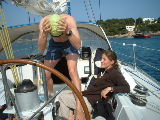
We motored into an Easterly on Friday, again sailing with one hand on the wheel and the other on the ‘phone as tenancy negotiations were finalised (subject to contract, as they say) just before close of Friday business.
On Saturday we were invited aboard Windsong by her American owners, John and Karen, together with another British crew who amazed us with their story of sitting in a restaurant on Menorca in May 2003 when the Algerian earthquake struck. They saw the resultant tidal wave cause the buoy to which their boat was anchored rise to such a height that the concrete anchor weight lifted off the seabed and the boat floated off into the distant sea, mooring line, buoy and concrete anchor weight all attached. Thanks only to the local coastguard were they able to retrieve it.
On Sunday Mark and Lizzy Jasper who we had met through Santa Ponsa community church came to visit. Mark, a triathlon athlete, calibrated the water temperature, determined it was warmer than Santa Ponsa and took a swim around the bay. As always, we enjoyed good discussions together.
Monday May 17th to Friday May 21st 2004. Porto Petro to Porto Colom, Mallorca. 5 miles.
On Monday we popped around the corner to Porto Colom with its well deserved reputation as the best natural harbour and anchorage in Mallorca: large, 5 – 10 metres deep and well protected. Bill and Shirley of K’Lai, who named their boat after an eagle from their native South Africa, showed us how to rig a “spider” harness to our dinghy so that we could winch it in and out of the water with minimal effort. Having built their own boat and sailed the long way round from South East Africa, via South America to the Med. during the early part of their retirement, they were now starting to contemplate returning via Suez.
On Tuesday we filled with water from the port. This was a mistake as the water was salty and not good for drinking. In the evening we went searching for Paella and found the highly recommended Restaurant Bon Port. The Paella was excellent, exceeded only by the quality of the company of the slightly eccentric and delightfully theatrical proprietor and his wife who gave us their undivided attention, warmth, and hospitality.
On Wednesday Pastor Rapheal and his wife Lorretta, from Santa Ponsa Community Church visited us. By this time I had put 15 patches on the dinghy, stopping most of water leaks through the floor and also found that by placing my body weight centrally and opening up the outboard throttle, I could get it to plane at speeds that, just a few inches above the water, felt exhilarating. Raphael, having much less body weight and proportionately more courage, achieved even greater speeds and whilst our wives made comparisons between men and boys, we had a great time. As always we appreciated their insights and openness.
Friday May 21st to Monday May 24th 2004. Porto Colom, Mallorca to Ciudadella, Menorca. 45 miles.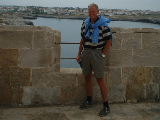
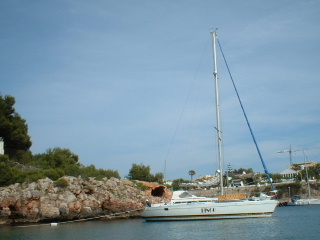
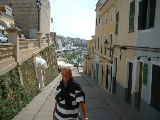
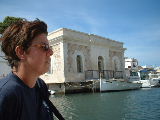
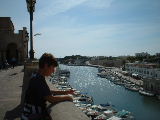
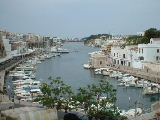
We had struggled for a week with a battery (135 AH capacity) that longer held charge, so we decided a replacement was needed. We sailed for Ciudadella at the west end of Menorca and broke our spell at anchor by tying up on the visitors quay. The local chandlery delivered a new battery, fitted it and took away the old one all within an hour.
The battery business completed, we learnt by text message that our friends from Trafalgar, Almerimar and Santa Ponsa, Neil and Anne, were negotiating Pia Wren into Ciudadella too. We enjoyed a meal together on a Saturday evening that stretched well into Sunday morning.
On Saturday morning I walked a few km inland to disused quarries which looked interesting from the tourist information handout. Undeterred by the unexpected presence of security guards and a padlocked gate, I walked around the corner, climbed a wall and joined, as spectator, a party to celebrate the Spanish royal wedding. Set in a perfectly cuboid quarried opening in the ground, approx. 100 feet on each side, a 40 piece wind ensemble entertained guests who were served drinks and refreshments from silver trays by bow-tied waitresses. The acoustic reflection from the musicians in one corner at the bottom to my ears at the opposite top corner was excellently balanced.
After a night on the quay we anchored in the tiny Cala d’en Busquat opposite and after much care and planning and a little advice from the harbourmaster, managed to lie quite happily between an anchor in the main channel and a line to the unforgivingly rocky shoreline behind. When a large catamaran manoeuvred around us and picked up his mooring buoys deeper into the Cala, we applauded.
Monday May 24th to Tuesday May 25th 2004. Ciudadella to Cala Santa Galdana, Menorca. 12 miles.
We sailed from Ciudadella on Monday morning with the intention of reaching Mahon at the opposite end of the island, but the mainly northerly wind reached 20 knots and rather than beat into this around the end of Menorca, we chose instead to tuck into Cala Santa Galdana, one of the many pleasant small bays that line the southern coastline. The Cala is about 500 metres wide, so a swim ashore was good exercise. We were surprised when a French boat anchored within arms length, but he kindly moved away when requested. We took the dinghy ashore, persuaded the manager of the only hotel to let us get a weather forecast via his internet connection and ate in a local beachside café. The Cala is a popular holiday resort and we were soon warding off visiting beach pedallos.
Tuesday May 25th to Thursday May 27th 2004. Cala Santa Galdana to Mahon, Menorca. 25 miles.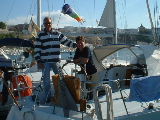

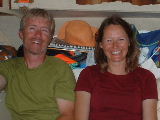
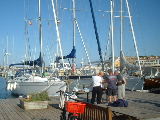
Tuesday brought a bracing wind, so we enjoyed a cracking good sail round to Mahon. I let the engine tick over to charge batteries for a short while whilst sailing at six to seven knots and made the mistake of leaving the engine in gear: the propeller was over-driven by the rushing water, and we developed an airlock in the fuel system which cut out the engine. The result was a pleasant sail into the long natural harbour at Mahon and, with a little help from other crews catching ropes, sailing onto a pontoon on Isla Clementina.
Mahon is the largest natural harbour in the Balearics, the prize for which the islands have been fought over. To increase yacht moorings, the harbour has two "floating islands", Christina and Clementina, each a rectangular arrangement of pontoons with lazy lines to accommodate 40 boats. Water and Electricity are provided, rubbish is collected and crews use dinghies to get ashore.
Clementina has a social atmosphere of its own, the predominantly British and German crews share the communal barbecue grill and garden furniture, and we were welcomed by two skippers who have lived aboard on this "island" for five years. We were quickly comparing notes on anchorages and laundries from Gibraltar to Scicily.
The engine was fixed in minutes, and I changed oil and filters according to the service schedule. On Wednesday Pia Wren arrived and we enjoyed drinks and chats with Anne and Neil together with the crew of Fair Winds II, Malcolm, Anne and Helen. Seven people were seated comfortably below decks on Bingo. Anne cooked for us aboard Pia Wren on Thursday evening before we took an early night. It was just what we needed: a relaxing evening with experienced sailing company to calm any nerves we might have before a long journey.
Friday May 28th to Sunday June 6th 2004. Mahon, Menorca to Carloforte, Isola di Pietro, Sardinia, Italy. 197 miles.
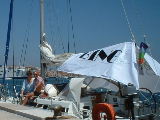
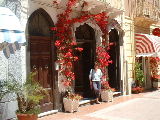
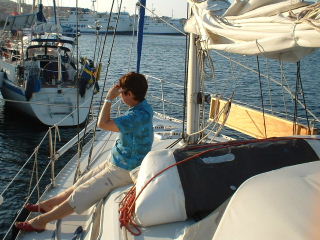

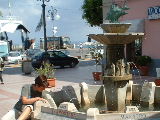
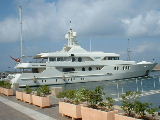
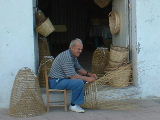
Walk and flamingos and cemetery
Leaving Mahon at 4 am Friday was straightforward, with well lit buoyage and gentle westerly winds. We sailed half of the 200 miles to Sardinia, downwind with cruising chute, genoa and main, 140 square metres of sail, and motored the rest when the wind died. A following swell caused a gentle but large roll every few minutes and added to the challenge of cooking and showering under passage. We saw dolphins, but for more than twenty hours we saw no other vessel. This was the longest passage we have planned for 2004.
Legend has it that St. Peter was shipwrecked on Isola di San Petro, and being first a fisherman and only second an apostle, he taught the islanders to catch Tuna. Carloforte, on the protected Eastern shore, facing Sardinia proper, perpetuates the apostolic example. We arrived on Saturday evening just as the annual Tuna festival was getting into swing with dancing in the streets and live rock music to midnight. The ice cream and pizzas were our first real taste of Italy, the music, however, was British rock. St. Peter had chosen a good place to come ashore.
The provincial town of Carloforte thrives on Tuna and tourism, several ferries arrive each day and one German family described it as the St Tropez of Sardinia. To cater for growth, a new quay has been built and awaits connection to water and electricity. We established from locals that we could tie up at no cost and within a few days our example was followed by arriving Germans, Brits, Dutch and Swedes. Within a week our flotilla was so large and colourful that a wedding party chose to drive up and have pictures taken in front of the boats. Our opportunism at finding a berth at no cost was exceeded, however, by a Dutch boat which anchored (for free) near the marina pontoons and trailed an electricity cable across.
We were invited aboard “Flying Eagle”, a 50 ft German Schooner, “Greta May”, crewed by Dave and Jane returning to the UK after three years in the Med. and chatted with several other crews too.
Sunday June 6th 2004 to Tuesday June 8th. Carloforte, Sardinia to Bizerte, Tunisia. 137 miles.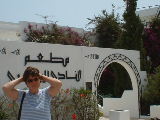
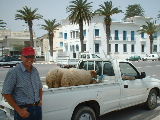

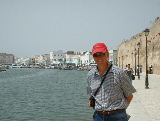
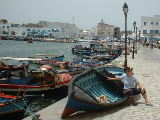
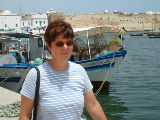
The North-westerly gale that had blown through the Sardinian Channel during the first days of June, finally settled on Saturday night and we left at first light Sunday with the last of the North West winds and 137 miles and 26 hours later arrived for breakfast in Bizerte, north Tunisia. Sunday was a magnificent downwind sail, flat seas, gentle winds, brilliant sun and thinking of Sundays in Bristol, we put on a sermon tape at just about the time the preacher would be getting on his feet at Christchurch Clifton.
There were plenty of other boats to watch all night and as we crossed the shipping lanes north of Tunisia with good visibility in the early hours before dawn. Two large container ships diverted course to avoid us. I found a new (to me) trick for keeping night watch. I tied a cooker timer set to five or ten minutes around my neck and caught short naps between lookouts.
Liz found fresh almonds and Halva in Bizerte market but resisted getting a live chicken. The night watchman had a morning nap. A Scottish crew invited us aboard on Monday evening and we exchanged tips on the Balearics for advice on etiquette in Muslim Tunisia. In their mid-sixties, and with Joan recovering from a double hip replacement, John and his wife decided to sell their more sporty boat and trade up to a Nicholson 48. The only model they could find was in Maine, so they bought in the States, sailed down the eastern seaboard, spent a season in the Caribbean, crossed via Bermuda and the Azores, spent a season in home waters, off the Clyde, and now, in their early seventies, they are in year four of a five year Mediterranean tour. Being quite open about their normal concerns for health and family, they are the inspirational examples we benefit from meeting.
Bizerte has a pleasant old port and parks, good shops and functioning internet. As our first stop in Tunisia, we were able to start to feel comfortable with the quite different customs and manners, not feel threatened by enthusiastic friendship, nor ill at ease when stared at. We are still adjusting to Tunisian toilets which have a hosepipe and tap instead of paper. With a little imagination you might also see the benefits.
Wednesday June 9th 2004. Bizerte to L’eau chaud, Korbous, Tunis. 46 miles. 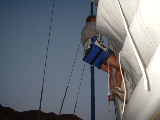
The coastal islands Pilau and Plane off Cap Farina are quite dramatic in brilliant sunlight. We reached the eastern side of the Bay of Tunis by 6pm and were grateful to find an anchorage well protected from the easterly wind. A sail slider had jammed, preventing the sail from being lowered fully and I needed nearly two hours up the mast to remove it. Had we tried to enter Sidi Bou Said marina on the windy west side of the bay with this problem, we could have had difficulties. L’eau Chaud, near Korbous has natural hot water springs and bathers were taking the waters until nightfall. Unfortunately we were too busy up the mast until darkness fell and took a shower on board instead.
Thursday June 9th to Monday June 14th 2004. Korbous to Sidi bou Said, Tunis. 10 miles.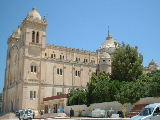
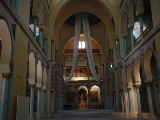
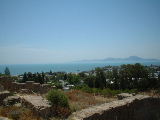
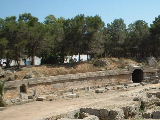
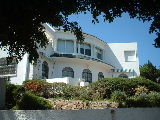
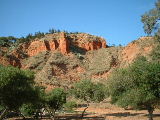
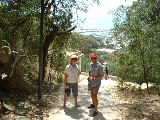
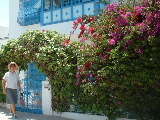
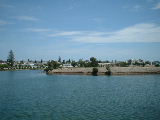
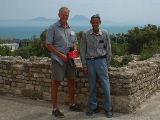
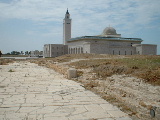
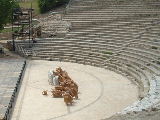
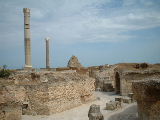
We raised anchor before six, crossed the bay of Tunis and entered Sidi Bou Said before eight. By mid-morning I was on top of Byrsa Hill, the highest point and heart of Carthage in Punic times, still the site of Loius IX’s cathedral and the buildings which now house the modern Carthage Museum.
The views over the bay of Tunis are difficult to describe adequately with either words or pictures. Mountain peaks south of the bay rise above a gentle white coastal sea mist and a turquoise blue sea. The sun is powerful, the stone ruins warm to sit on and trees provide welcome shade. I also saw the Punic ports, Amphitheatre and a further museum on my first visit.
Friday took in the Oceanographic museum and the Punic Tophet where children were sacrificed. (The Phoenicians sacrificed the first male child at age eleven. Victims were beheaded and burnt.) Hannibal’s villa and surrounding houses were brought alive by a guide who gave a knowledgeable and interesting 50 minute tour. Amongst the ruins, the Roman baths and theatre have probably suffered least from generations of pillaging. Archaeology has followed in the steps of generations who have robbed the stone from Carthage to build homes in Tunis. However, taking all the excavated sites and museums together it is possible to see how Carthage competed with Rome for control of the Mediterranean. The few remains told the story of a city that had been great several times, under Punic, Roman and Byzantine rule. It is now a rambling suburb of modern Tunis, a city that reflects its French colonial past and present independence.
The buildings in Carthage are all painted white and a uniform blue, designed to ward of mosquitoes. When done well, and with flourishing bougainvillea, the colourful effect is picturesque. At the station, however, the white paint applied to the walls also coats the weeds growing through cracks in the walls and the grass growing up the side. At the port, the fresh blue applied to the bollards also covers the ropes and chains wrapped around them.
On Friday evening we were invited aboard a neighbouring boat for drinks. Skamal 2, named after the owner’s two sons, is identical to Bingo in model and vintage, so its Tunisian owner, Amira was as keen as us to exchange notes and ideas. We will probably copy his lazy jacks and he took careful note of our windlass mounting. I mentioned my sail slider problem and asked if he knew anyone locally who could fabricate parts in stainless steel. Mons. Noira, an architect, asked for a rough engineer’s sketch. By the following morning he returned with the hand made parts I needed and refused to accept any payment.
Saturday was rest day and guess what. “Hello Bingo” came a shout from Pia Wren, arriving mid-afternoon. We climbed together to Sidi bou Said and enjoyed the local brew: mint tea sweetened with sugar and with pine kernels floating on top. Surprisingly refreshing.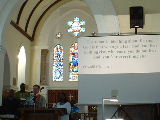
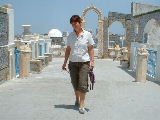
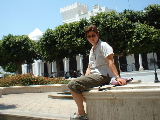
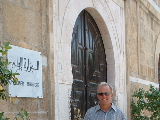
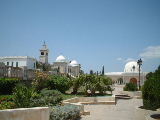
On Sunday we took an early train into Tunis and joined 150 worshippers at St George’s Anglican church. The congregation was mostly sub-Saharan African drawn from the employees of a bank that had withdrawn 2000 employees to Tunis from war torn Ivory Coast. There were a few Arabs and Caucasians. The teaching and music were to a high standard. Church took more than two hours and we had no time to greet the preacher, so after touring the Medina and lunch, we returned to the Port de Plaisance at Sidi Bou Said.
Saturday June 19th to Tuesday June 22nd 2004. Sidi bou Said, Tunis to Mazara del Vallo, Sicily, via Cap Bon. 124 miles.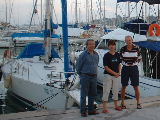
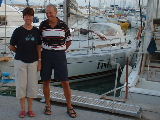
Amira our neighbour, a lady friend and his lifelong buddy Patrick joined us for drinks on Monday evening. Amira kindly copied a thick boat owner’s instruction manual for me. Patrick, who managed three Tunisian factories making high quality ladies lingerie for the French brand Lise Charmel, invited Liz for a factory tour and access to goods at cost price. Patrick collected Liz from the port on Tuesday afternoon and returned her with purchases two hours later. We had been pleased also to meet Patrick’s wife, son and son’s student girlfriend. Tunisian culture still felt strange, but generous kindness from Amira and Patrick assured us that we had already made friends we could call on if needed.
On Tuesday I needed an internet café to download and print out the new rental contract or our Oxford home, so I tried Tunis. A uniformed officer near Tunis Marin station directed me south, then a newsagent directed me west, finally a police officer sent me East to Internet Barcelone. After a ten minute wait I was offered a computer with several key legends worn away, two keys permanently depressed and liable to repeat after the lightest touch and no external disc drive. After spending an hour typing notes on-line, the connection went down. The manager shrugged her shoulders, but allocated me another computer which at least had a working keyboard. Thankfully we have a highly professional rental agent who had personally prepared the contract and which was ready to sign. I wanted to email back to him, but again the connection went down. I paid up, tried to remain polite as I explained that after spending two hours just to download a document this was the worst internet point I had ever used. More shoulder shrugging. I ‘phoned the agent in Abingdon, and looked for lunch. The waiter took me to get a photocopy of the contract and an assistant in a shop emptied her cupboards to find envelopes for me and insisted I accept them as a gift, refusing payment.
On the TGM return ride the carriages were full, standing room only and the sun was hot. A teenage lad, in an act of bravado, wedged himself in a doorway holding a pair of doors fully open as the train accelerated away, to allow in a welcome breeze. A young woman nearby, alert to the danger, challenged him with a quizzical smile and after a short time the lad stood aside, allowing the doors to spring closed. Then a young man across the carriage beckoned the lad who went to him. The young man rested an arm gently on the boy’s shoulder and spoke to him quietly for a few minutes. Clearly the boy was being reprimanded by a stranger, but with such mildness that he was unable to take offence.
On Tuesday evening we ate out with Neil and Anne in Sidi Bou Said. We set out after dark and were unable to take the unlit steps as a shortcut. So in heavy rain we walked the Boulevard d’Environment and offered the waiter at La Bagatelle four dripping raincoats and a wet brolly. The fish was tender, the couscous filling, the bill reasonable and the conversation entertaining as always. Our coats had dried and the waiter summoned a taxi back to the port.
On Wednesday we headed to Tunis again for the Bardo museum. As rain threatened we were glad to jump in a taxi at the port. Before pulling off we queried the cost and faced with an aggressive argument and a cost proposal ten times higher than the previous day for the same journey, we stepped out again and walked. The taxi driver failed in his attempt to find other customers at the port, wound down his window as he later drove past, shouted something in Arabic which we were glad not to understand and gave a rude hand sign that we understood all too well.
At the Bardo metro stop the rain was heavy and we were glad that a mild mannered taxi driver took us the few hundred yards to the museum in the dry and at a metered price.
The Bardo is primarily a feast of Roman mosaics housed in 50 rooms and galleries in a 19th century palace which belonged to a Bey or Regent which itself has interesting ceilings of painted wood and sculpted plasterwork. Mosaics celebrate the gods, the wealthy estates of patrons, the seasons, great battles and scenes of nature. One whole area is devoted to maritime scenes. One mosaic forms a catalogue of Roman types of shipping, another shows different sea creatures. There are also areas devoted to prehistoric archaeological finds, and one to a Roman ship that sank off Tunisia in the first century AD whilst carrying ancient Greek artefacts from Athens to Rome. Highly recommended.
Wednesday night brought heavy storms; a bucket in the cockpit collected ten inches. Around 2 am, with the wind reaching 30 knots (we don’t go out if more than 20 knots is forecast,) I remembered our sun cover was still tied over the cockpit. Would it still be there in the morning or blown half way to Libya? The thought nagged, sleep wouldn’t return until it was safely stowed, so braving the wind and rain I struggled to fold it safely away. The rain blew right into the companionway and our cabin took in water during those few minutes on deck. A large Genoa had become unfurled on a boat across the marina and more than £1000 worth of sail was flogging itself to shreds in the wind. Should I venture out and try to get on board and secure it? A good deed perhaps, but were the marina staff aware and would they help? Sleep overtook these thoughts. When I woke again a few hours later, my first instinct was to look across and see the flogging sail had been safely furled. Having covered many of the hatches with nets to allow a cool breeze in and keep mosquitoes out at night, we shut them tight on Wednesday night. Unfortunately the fine netting remained trapped in the hatches and the water seeped through. At dawn we were lying in puddles, our bed clothes soaked.
Thursday brought a drying breeze. We tied a line between two lamp-posts and hung our cockpit cover to dry. Bedding and mattresses were secured on deck and a warm drying wind blew through the cabin. The marina secretary, normally cool, friendly, helpful and efficient was harassed. She had a list of owners to contact with damage reports. I trekked 20 minutes to the station, 10 minutes on the TGM, 5 minutes on foot to Salambo internet café for a 3 day weather report. At 5 minutes per page update, there was plenty of time to read the wall mounted signs advising the strict prohibition against attempts to access prohibited sites. The warning was circular, but in a Muslim country it was not hard to imagine the definition of “interdit.” Perhaps the slow data rate was an intentional deterrent to surfing naughty sites. After an hour I was satisfied that Friday and the weekend would bring decreasing NW winds, ideal for either Sicily or Malta.
As a compromise we decided on Malta via Sicily, the aim being to limit night sailing by coast hopping. Sidi Bou Said to Sicily was 122 miles, the longest hop. The rest would be day-sails. Thursday evening was spent preparing for the journey: changing our home from caravan to sailing mode. Cooking a large stew with lots of vegetables. Food that would do for two main meals if the weather was rough, prepared in the pressure cooker and secured snugly in our fridge. We filled with water, topped the engine oil, prepared charts and routes, entered GPS waypoints, and checked for harbours of refuge. We ended the evening with a sun-downer on Pia Wren and took an early night.
By 7:15 on Friday morning I was already at the police and customs office. The clearance paperwork took nearly 45 minutes and at least 5 people in the office and several telephone calls were involved. The Marina office opened at 8:00 am and the early morning weather bulletin was promised imminently. Two hours later, when the forecast was finally posted, it heralded winds up to 35 knots. Debate was not needed. We were port bound for another 24 hours. The police and customs sucked through teeth, scowled and gave me several lectures when asked to undo all the paperwork over which they had laboured with such effort only two hours earlier. I resolved not to be intimidated and remain polite. The weather was unsafe, we were staying another day in Sidi Bou Said and they could be as difficult and disapproving as they wished. After several more phone calls, lots of huffing and blowing, and a final lecture, our paperwork was restored.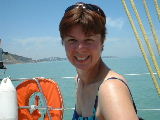
Saturday morning brought little wind to the marina, a forecast of 15 – 20 knots in North Tunisia and decreasing. This confirmed the forecast that Neil and Anne had wrestled from the internet on the previous evening. I braced myself to confront the police and customs and found a different officer on duty, weekend shift change I suppose. The necessary formalities were completed in 5 minutes, the officer smiled, shook me firmly by the hand and wished us Bon Voyage. The day had started well. We would leave together with Pia Wren who would sail directly to Malta.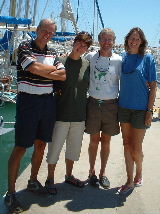
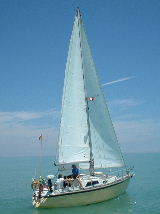
We shared Neil and Anne’s remaining Dinar coins and were each able to buy fresh bread and phone home. We spent an hour sailing together at less than 3 knots, circling each other to take pictures. I removed my shirt, Neil took one look and said he lacked a sufficiently wide angled lens. The start was sunny and cheery, the sea absolutely flat, the cause: almost no wind. Anne and Neil’s patience and experience at alternating watches allowed them to sail along happily at 2 knots, prepared to take several days over the journey. To reach Sicily by nightfall on Sunday we needed to average 4 knots, so we started our engine. By mid afternoon we were sailing well in 10 knots of wind and by late afternoon as Cap Bon came in sight, we had more than 15 knots and two reefs to reduce Main sail area.
But the sun had long since disappeared. Storm clouds were gathering. As we reached Cap Bon the wind was above 25 knots, our sails were heavily reefed and yet we were exceeding 7 knots hull speed, sometimes being carried by a rolling wave to over 9 knots. The open seas lay ahead, shipping lanes to cross in the dark with the likelihood of rain to reduce visibility and building seas to prevent sleep. We still had more than 80 miles to Sicily as the black sky brought premature dusk. 
From Rod Heikell’s excellent pilot book we found an anchorage, Ras el Drek, on the East side of Cap Bon, just 7 miles away. We were directed to find refuge from strong westerly winds between a rocky outcrop and the wreck of a ship which may or may not be lit with a navigation light, depths uncertain. It sounded challenging in daylight but light was diminishing and wind increasing. As we rounded Cap Bon, the wind reached 35 knots, the rocky outcrop wasn’t easy to discern in the failing light, we were relying on GPS more than I liked. We spotted a boat at anchor before we saw the mast of the wreck, then we saw another yacht at hook. We were both harnessed and I climbed on deck to drop the sail in 35 knots of wind. The wind reduced as we tucked in between the two vessels, we dropped our faithful CQR (phonetic “Secure”) and prayed it would hold. With 40 metres of chain we tested the anchor by revving our engine in reverse. It was firm. We were sheltered.
As the storm passed overhead we watched both sheet and forked lightning and recorded 35 knots wind-speed even in the lee of this protective steep sided shore. After showering and eating, Liz took the first anchor watch, with instructions to wake me when she went to sleep unless the storm had safely passed. Liz was still reading in bed when I woke before midnight. The calm was tangible, no humming of shrouds, no whistling, just a gentle lapping against the hull. I sat on deck in a warm gentle breeze. Stars were appearing as the sky was clearing in the west. Lightning still visible at a distance in the east.
We rose before 4am. To reach Sicily by nightfall we needed an early start. The red morning sun broke in the east as we approached the shipping lanes. The wind strengthened, then fell away. We shook out the reefs, then the wind strengthened again so we reefed the main again and furled the Genoa. The Mediterranean has a reputation for fluky winds and we had hardly 30 minutes in 16 hours without the need for adjusting sails as wind speed and direction varied.
We reached within 7 miles of the coast when Sicily first appeared. The port of Mazara del Vallo has an extended breakwater providing a large anchorage with shelter from winds from SW round to NE. We anchored the boat in 3 metres of water (Tidal range of zero in Sicily,) a gentle ripple on the surface and a soft breeze. The shoreline was gaily lit and music wafted across the bay. By 10 pm we had launched our dinghy, tied ashore on a pontoon, passed security night-watchmen with a cheery Buona Sera and were strolling the busy streets, throbbing with finely dressed Sicilians, past restaurants overflowing with customers and into the main Piazza to find a ‘phone. Today was my father’s birthday. After dialling the information number and selecting English we learned that Italian street-phones take Visa cards. Much better than reversing charges for a birthday greeting. We sang “happy birthday” into the receiver, remembered the plural for Italian’s favourite breakfast drink; Cappuchi, and drank in the sheer vitality of Sunday evening in a provincial fishing town in SW Sicily. After changing continents, we felt we were coming home.
The dinghy had sprung more leaks, we got wet feet, but who cared? A little Spanish brandy and sleep came easily.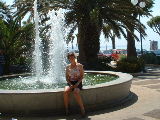
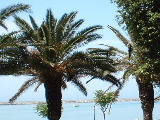
Perhaps reading Homer’s Odyssey had released a longing for home. We had been away more than 3 months ( cf. Odysseus 20 years). To go home now would require finding a berth in the peak expensive months. The Tourist Information girl spoke a little English and assured us that the harbour was just for fishing boats, we would not find a berth here and furthermore we could not anchor in the bay. The newsagent spoke better English and his young friend Florence drove us across town, whistling and waving at the girls he knew and introduced us to the Director of the Mazara Ass. Diportisti Nautici Mazaresi (Yacht club) who was keen to fill his empty berths and offer us attractive terms. Ryanair offered a good deal to bring our planned return forward and on July 1st we will be back in Bristol. Odysseus would have sacrificed a beast to the Gods in recognition of a safe landfall, we spent time in the cathedral. We have a week in Sicily to relax and brush up on a little Italian in preparation for the rest of the summer.
The Cameriere in the internet Gelateria has used a flat spatula to amass a gravity defying mountain of chocolate ice cream on to a small cone and I am now licking at speed to keep drips out the keyboard. Enjoy your summer!